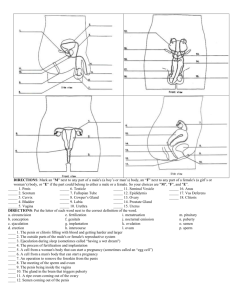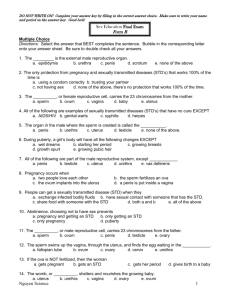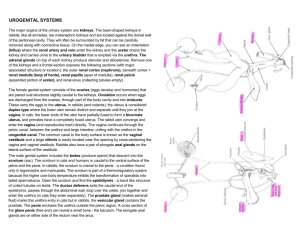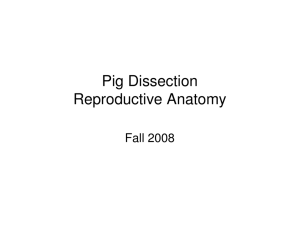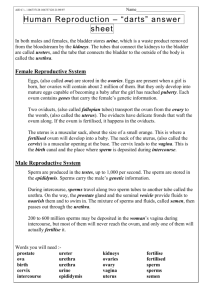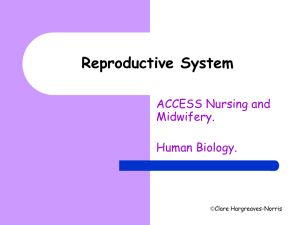Human Reproduction
advertisement
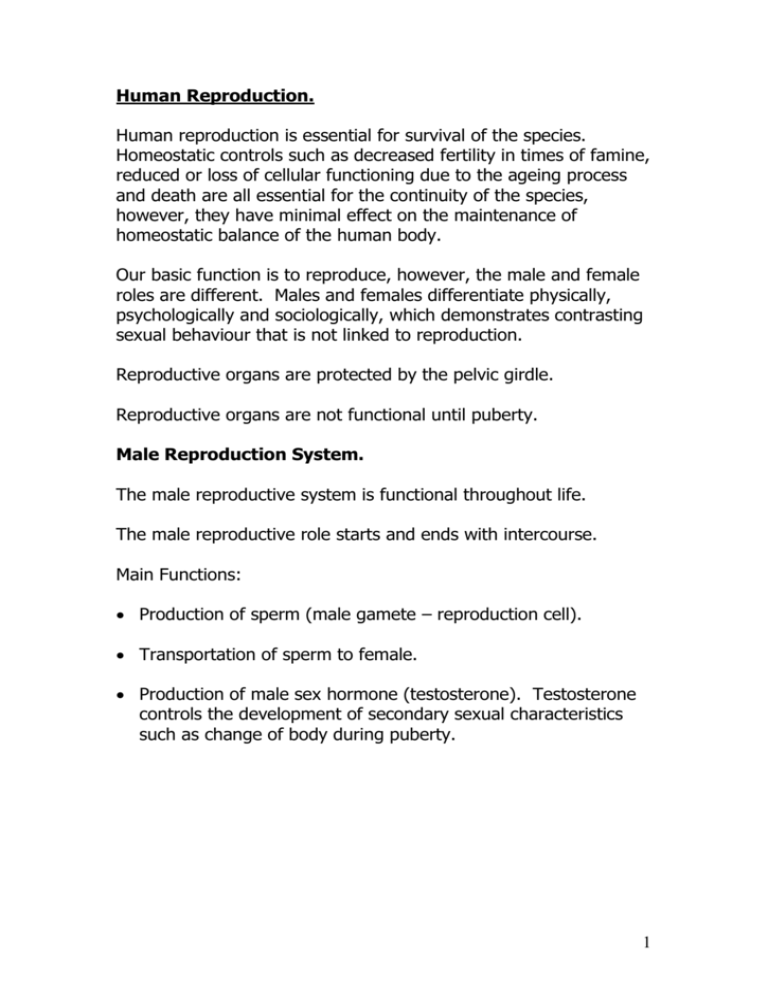
Human Reproduction. Human reproduction is essential for survival of the species. Homeostatic controls such as decreased fertility in times of famine, reduced or loss of cellular functioning due to the ageing process and death are all essential for the continuity of the species, however, they have minimal effect on the maintenance of homeostatic balance of the human body. Our basic function is to reproduce, however, the male and female roles are different. Males and females differentiate physically, psychologically and sociologically, which demonstrates contrasting sexual behaviour that is not linked to reproduction. Reproductive organs are protected by the pelvic girdle. Reproductive organs are not functional until puberty. Male Reproduction System. The male reproductive system is functional throughout life. The male reproductive role starts and ends with intercourse. Main Functions: Production of sperm (male gamete – reproduction cell). Transportation of sperm to female. Production of male sex hormone (testosterone). Testosterone controls the development of secondary sexual characteristics such as change of body during puberty. 1 Prostate Gland. The prostate gland is a small gland situated between the bladder and the rectum. It surrounds the beginning of the urethra. The prostate gland produces two secretions that are carries in semen. One helps to keep the lining of the urethra moist. The other is part of the seminal fluid that helps the semen to travel along the urethra and into the female. Testes. The testes are the male gonads (reproductive glands) that are contained within a sac of skin and muscle called the scrotum. The testes produce sperm and testosterone. Sperm are developed and stored in the testes because they need to be kept at a lower temperature than the average body temperature (35degrees C). Epididymis. The epididymis is a tightly coiled tube, which opens from the top of each testicle, continues down along the side of the testicle, then straightens out into the vas deferens. Immature sperm is stored in the epididymis until it matures and can be transported to the vas deferens. Vas deferens. The vas deferens is a duct with small walls leading from the epididymis to the urethra. Mature sperm is stored in the vas deferens until it is transported to the urethra during sexual activity. The sperm is pushed along by muscular contraction of the muscular walls (peristalsis). 2 Scrotum. The scrotum is an external sac that contains the testes, epididymid and vas deferens. The scrotum hangs under the penis. The scrotum consists of an outer layer of skin and an inner layer of muscle. It is divided into two halves by a membrane. Each half contains a testicle. The scrotum supports, protects and maintains the correct temperature for the testes. The testes are usually outside the body to keep them around 35degrees C. If the scrotal temperature drops the muscles contract to bring it closer to the body thus raising the temperature of the testes. If the temperature becomes too high, then the muscles relax, causing the scrotum to fall away from the body, thus lowering the temperature of the gonads. Penis. The penis is the main external organ of the male. It has three important parts; erectile tissue bodies, prepuce (foreskin) and the urethra. The penis has three bodies of spongy erectile tissue all running lengthways down the side of the urethra thus forming a tube for the urethra. The tip of the penis is formed from erectile tissue and is known as the glans penis. The eretile tissue is full of blood vessels. The prepuce protects the glans penis. The penis has two important functions: Excretory organ: It carries urine from the bladder for excretion. Reproductive organ: It becomes erect during sexual activity. The erection is caused by an increase in the amount of blood circulating in the spongy tissues. This causes the tissues to swell and the penis becomes enlarged and rigid therefore able to penetrate the female vagina and safely deliver semen during intercourse. While sexual intercourse is taking place the body’s reflexes prevent urine from entering the urethra. 3 Sperm. Sperm look like tadpoles under a microscope. Each one consists of a head, (the sex cell with a nucleus containing the genetic material), a middle, (containing numerous mitochondria that provide ATP for movement), and the tail, a flagellum (thread like structure) that propels the sperm along to its destination. One sperm is required to fertilise one ovum although there are millions of sperm in semen. The head of the sperm inserts itself into the ovum and the rest is broken down and reabsorbed. The fertilised ovum then grows and develops into a baby. Female Reproductive System. The female reproductive system is functional until menopause. The female reproductive role starts with intercourse and ends in childbirth. 4 Main functions: Production of ova (female gamete - egg). Receive sperm from male. Produce progesterone and oestrogen (female sex hormones). Prepare for pregnancy each month. Protect and nurture the embryo (fertilised ova – 8th week) and developing foetus (9th week – birth). Deliver the baby at 40 weeks. (Owtch, ooyah, hellppp meeee!) Uterus (womb). The fertilised ovum grows into a baby in the uterus. The top end opens out into the Fallopian tubes (leading to the ovaries). The cervix at the lower end opens into the vagina and forms the birth canal. The uterus is a muscular, hollow organ. It is approximately the size and shape of an upside down pear in its non-pregnant state. It expands during pregnancy to accommodate the foetus. The lining of the uterus consists of layers of tissues that respond to hormonal secretions. Every month the layers prepare for pregnancy by thickening up to provide a nourishing bed for the fertilised ovum. Menstruation occurs otherwise. Cervix. The cervix is the narrow neck of the uterus that opens into the vagina. It is normally the width of a pencil however it dilates during childbirth to allow the baby to pass through. The cervix forms the first part of the birth canal. The midwife takes measurements as the cervix dilates to assess the time of birth. 5 Ovaries. The ovaries are the female gonads. They are approximately the size and shape of almonds and are positioned on each side of the uterus just below the Fallopian tubes. The ovaries secrete progesterone and oestrogen, which are hormones responsible for female secondary sexual characteristics. The ovaries also store ova. When girls are born they already have their ova however they are in immature and contained in follicles. After puberty one ovum is released every month. This is called ovulation. Follicle. Follicles are small structures on the surface of ovaries. They contain fluid and an ovum. When an ovum is mature for fertilisation the follicle splits to release the ovum, which then travels along the Fallopian tube to the uterus. Fallopian Tubes. The Fallopian tubes are funnel shaped and start at the top of the uterus, going along to the ovaries. The Fallopian tubes provide a passageway for the ovum from the ovaries to the uterus. Ova become fertilised in the Fallopian tubes. Vagina. The vagina is a muscular passage leading from the cervix to the vulva. It connects the internal sex organs to those on the outside. Blood vessels within the vagina become swollen and engorged with blood during sexual intercourse. The vagina has several purposes: It is a passageway for menstrual blood. It forms part of the birth canal during labour. It is the site for penetration during sexual intercourse. 6 The Vulva. The vulva is the collective name for the external organs of the female reproductive system. They include: Mons pubis: A pad of protective fat over the symphysis pubis, which is covered with hair after puberty. Labia majora: Two large outer ‘lips’ of fatty tissue that run down both sides of the vulva from the mons pubis to the perineum. They protect the entrance to the vagina and urethra. Labia minora: Two smaller folds of skin within the labia majora, which surround the clitoris to protect it similar to the male prepuce. Clitoris: Just like a very small penis, sensitive and containing erectile tissue. It is situated just below the mons pubis. The erectile tissues fill with blood and swell up during sexual intercourse. 7


